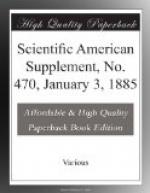The nature of the outflow was like that produced by the pouring of strong spirit into water. But no power that we could employ was capable of detecting a granule in it. To our most delicate manipulation of light, our finest optical appliances, and our most riveted attention, it was a homogeneous fluid and nothing more. This for a while baffled and disturbed us. It lured us off the scent. We inferred that it might possibly be a fertilizing fluid, and that we must look in other directions for the issue. But this was fruitless, and we were driven again to the old point, and having once more obtained the emitted fluid, determined to fix a lens magnifying 5,000 diameters upon a clear space over which the fluid had rolled, and near to the exhausted sac, and ply our old trade of watching with unbroken observation.
The result was a reward indeed. At first the space was clear and white, but in the course of a hundred minutes there came suddenly into view the minutest conceivable specks. I can only compare the coming of these to the growth of the stars in a starless space upon the eye of an intense watcher in a summer twilight. You knew but a few minutes since a star was not visible there, and now there is no mistaking its pale beauty. It was so with these inexpressibly minute sporules; they were not there a short time since, but they grew large enough for our optical aids to reveal them, and there they were. Such a field after one hour’s watching I present to you. And here I would remark that these delicate specks were unlike any which we saw emerge directly from the sac as granules. In that condition they were always semi-opaque, but here they were transparent, and a brown yellow, the condition always sequent upon a certain measure of growth.
To follow these without the loss of an instant’s vision was pleasure of the highest kind. In an hour and ten minutes from their first discovery they had grown to oval points. In one hour more the specks had become beaked and long. And this pointed end was universally the end from which the flagellum emerged. With the flagellum comes motion, and with that abundant pabulum, and therefore rapid growth. But when motion is attained we are compelled to abandon the mass and follow one in all its impetuous travels in its little world; and by doing so we are enabled to follow the developed speck into the parent condition and size, and not to leave it until it had, like its predecessors, entered on and completed its wonderful self-division by fission.
It becomes then clearly manifest that these organisms, lowly and little as they are, arise in fertilized parental products. There is no more caprice in their mode of origin than in that of a crustacean or a bird. Their minuteness, enormous abundance, and universal distribution is the explanation of their rapid and practically ubiquitous appearance in a germinating and adult condition. The presence of putrefiable




